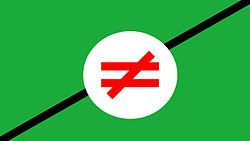Pan-Iranist Party
|
Pan-Iranist Party
|
|
|---|---|
| General Secretary | Zahra Gholamipour |
| Founder | Mohsen Pezeshkpour and Dariush Forouhar |
| Founded | 1941 |
| Headquarters | Tehran, Iran |
| Newspaper | National Sovereignty |
| Ideology | |
| Political position | Far-right |
| Colors | Green, White, Red (Iranian Tricolore) |
| Parliament |
0 / 290
|
| Election symbol | |
| ≠ | |
| Party flag | |
 |
|
| Website | |
| paniranist-party |
|
The Pan-Iranist Party (Persian: حزب پانایرانیست, translit. Ḥezb-e Pān Irānist) is a small opposition political party in Iran advocating pan-Iranism. The party is not registered and technically illegal, however it continues to operate inside Iran.
During the Pahlavi dynasty, the party was considered a semi-opposition within the regime, allowed to operate until denouncing Iran's assent to Bahraini independence in 1971.
The invasion of Iran by Anglo-Soviet armies in the early 20th century led to a sense of insecurity among Iranians who saw the king, Reza Shah, powerless against such foreign presence in the country. There were soldiers from Russia, England, India, New Zealand, Australia and later on, America, present in the country, especially in the capital, Tehran.
The Anglo-Soviet invasion of Iran influenced a series of student movements in 1941 where nationalism was gaining popularity more than ever between Iranians, one of these new groups was an underground nationalist guerrilla group called the Revenge group (also known as the Anjoman).
The Pan-Iranist Party was founded later on by two of the members of the revenge group and two other students in the mid-to-late 1940s in Tehran University. Though the pan-Iranist movement had been active throughout the 1930s, it had been a loosely organized grass roots alliance of nationalist writers, teachers, students, and activists. The party was the first organization to officially adopt the pan-Iranist position, which believed in the solidarity and reunification of the Iranian peoples inhabiting the Iranian plateau.
...
Wikipedia
